Shirley Temple Revisited, Part 10
On July 30, 1936 there was a story conference on what would become Shirley’s next picture after Stowaway. At that conference, according to notes published in Rudy Behlmer’s Memo from Darryl F. Zanuck, the Fox studio chief said:
I feel the only way to make this story is to disregard the formula of all the previous pictures Shirley Temple has appeared in to date…My idea…is to forget that it is a Shirley Temple picture. That is, not to forget that she is the star, but to write the story as if it were a Little Women or a David Copperfield…All the hokum must be thrown out. The characters must be made real, human, believable. Only then can we get a powerful, real story.
The role must be written for Shirley as an actress, and nothing sloughed over because Shirley is in it and therefore it will be good. We don’t want to depend on any of her tricks. She should not be doing things because she is Shirley Temple, but because the situations — sound and believable — call for them. In other words, write a role and let Shirley adapt herself to the picture.
This conference took place almost a full year before the picture was released. Without checking studio archives, we can’t be sure if Zanuck had already assigned a director, but given his determination to disregard the Shirley Temple formula, he probably had. In any case, the assignment went to John Ford, whom Zanuck had under non-exclusive contract. Ford had been directing since 1917, had already won the first of his four Oscars for The Informer at RKO, and was on the threshold of his own personal Golden Age, which would extend into the 1960s. According to Ford biographer Scott Eyman, Ford gave two accounts of his reaction to being assigned a Shirley Temple picture. In the one Eyman finds more likely, Ford said “my face fell atop the floor.” In the other, more consistent with the director’s self-image as a no-nonsense moviemaker, “I said ‘Great’ and we just went out and made the picture.”
Wee Willie Winkie
(released July 23, 1937)
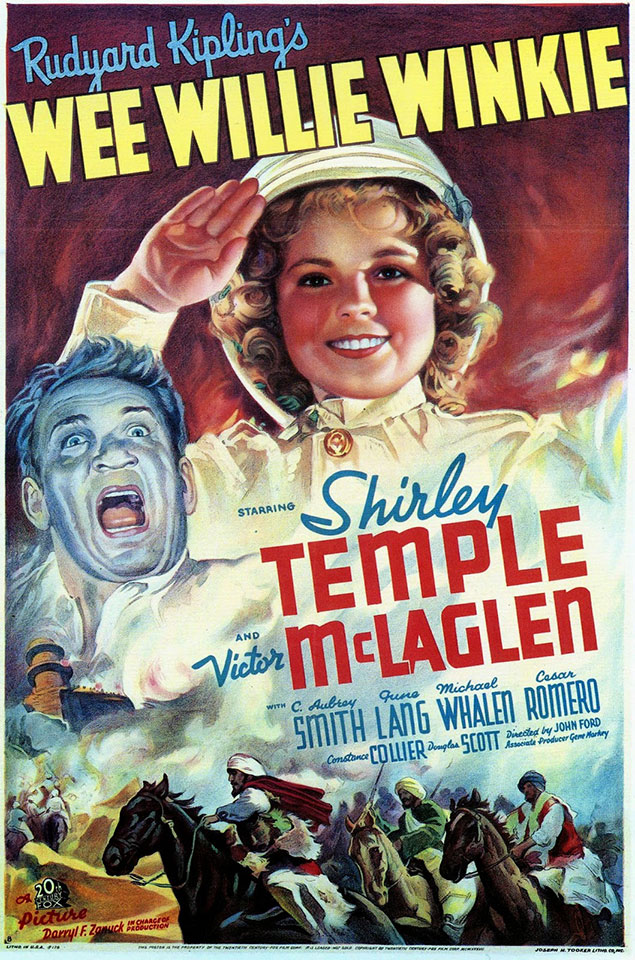 Calling the picture “Rudyard Kipling’s” Wee Willie Winkie was a bit of an overstatement. The original story was published in 1888, when the future Nobel Prize winner was 22. It told of Percival William Williams, the six-year-old son of an army colonel stationed with his regiment in British India at the foot of the Khyber Pass on the indistinct border with Afghanistan. Percival has a penchant for nicknaming people, including himself, so he has adopted the name Wee Willie Winkie from one of his nursery-books. Winkie is bright but typically mischievous for a boy his age, and under the military discipline imposed by his father he is forever earning, then forfeiting, a succession of Good Conduct Badges.
Calling the picture “Rudyard Kipling’s” Wee Willie Winkie was a bit of an overstatement. The original story was published in 1888, when the future Nobel Prize winner was 22. It told of Percival William Williams, the six-year-old son of an army colonel stationed with his regiment in British India at the foot of the Khyber Pass on the indistinct border with Afghanistan. Percival has a penchant for nicknaming people, including himself, so he has adopted the name Wee Willie Winkie from one of his nursery-books. Winkie is bright but typically mischievous for a boy his age, and under the military discipline imposed by his father he is forever earning, then forfeiting, a succession of Good Conduct Badges.
One soldier that Winkie takes a particular shine to is Lt. Brandis, whom he nicknames “Coppy” for his copper-colored hair. His affection for Coppy is so great that when he sees Coppy “vehemently kissing” the daughter of one Major Allardyce he keeps the secret to himself.
Shortly thereafter, for yet another infraction, Winkie once more loses his Good Conduct Badge and is “confined to quarters under arrest” — what a later generation would call “grounded”. But when he sees Coppy’s Miss Allardyce, in a fit of willful independence, riding out beyond the river where all are forbidden to go, Winkie breaks arrest and rides after her on his little pony.
He catches up only when her own horse stumbles and throws her, twisting her ankle so that she cannot stand. She pleads with him to ride back to the post for help. But Winkie has been taught that “a man must always look after a girl”, and when he sees men approaching from the hills — bandits, perhaps, or worse — he dismounts and whips his pony, sending it galloping home without its rider. When the natives come across the boy and the injured young woman, they begin mulling over whether to take them hostage for ransom.
Winkie bravely stands up to them, to their great amusement, ordering them to send to the post for help. One of the natives, a former groom at the post, warns his fellows that disturbing these two will only be asking for trouble, and the debate among them goes on long enough for Winkie’s pony to reach home and for the alarm to be sounded. As the regiment rides to the rescue, the Afghans see the approaching soldiers and prudently melt back into the hills. Winkie and Miss Allardyce are brought back to the post, where Winkie is hailed as “a pukka hero”; his breaking arrest is forgiven, and he even regains his Good Conduct Badge.
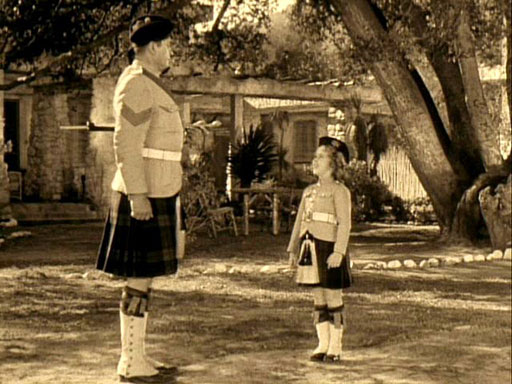 Needless to say, in Ernest Pascal and Julien Josephson’s screenplay nearly all of this was changed. Percival was changed to Priscilla and given a widowed American mother (June Lang). The colonel backs up a generation, becoming Priscilla’s grandfather (C. Aubrey Smith), who sends for Priscilla and her mother when he learns they are living in poverty in America. Priscilla is still nicknamed Wee Willie Winkie, but her military discipline is self-imposed in an effort to become a soldier, since that seems to be the only type of person her grandfather the colonel likes. “Private” Winkie still takes a shine to Lt. “Coppy” Brandis (Michael Whalen, Shirley’s father in Poor Little Rich Girl), but he throws over Maj. Allardyce’s daughter to romance Winkie’s mother. While he’s doing that, Coppy’s duties as Winkie’s best friend among the soldiery devolve onto a new character, Sergeant MacDuff (Victor McLaglen).
Needless to say, in Ernest Pascal and Julien Josephson’s screenplay nearly all of this was changed. Percival was changed to Priscilla and given a widowed American mother (June Lang). The colonel backs up a generation, becoming Priscilla’s grandfather (C. Aubrey Smith), who sends for Priscilla and her mother when he learns they are living in poverty in America. Priscilla is still nicknamed Wee Willie Winkie, but her military discipline is self-imposed in an effort to become a soldier, since that seems to be the only type of person her grandfather the colonel likes. “Private” Winkie still takes a shine to Lt. “Coppy” Brandis (Michael Whalen, Shirley’s father in Poor Little Rich Girl), but he throws over Maj. Allardyce’s daughter to romance Winkie’s mother. While he’s doing that, Coppy’s duties as Winkie’s best friend among the soldiery devolve onto a new character, Sergeant MacDuff (Victor McLaglen).“The owners of a child star are like leaseholders — their property diminishes in value every year…Miss Shirley Temple’s case, though, has peculiar interest: Infancy is her disguise, her appeal is more secret and more adult. Already two years ago she was a fancy little piece (real childhood, I think, went out after The Littlest Rebel). In Captain January she wore trousers with the mature suggestiveness of a Dietrich: her neat and well-developed rump twisted in the tap-dance: her eyes had a sidelong searching coquetry. Now in Wee Willie Winkie, wearing short kilts, she is completely totsy. Watch her swaggering stride across the Indian barrack-square: hear the gasp of excited expectation from her antique audience when the sergeant’s palm is raised: watch the way she measures a man with agile studio eyes, with dimpled depravity. Adult emotions of love and grief glissade across the mask of childhood, a childhood skin-deep.
“It is clever, but it cannot last. Her admirers — middle-aged men and clergymen — respond to her dubious coquetry, to the sight of her well-shaped and desirable little body, packed with enormous vitality, only because the safety curtain of story and dialogue drops between their intelligence and their desire.”
Greene closed out with a left-handed compliment, noting that the story was “a long way after Kipling. But we needn’t be sour about that. Both stories are awful, but on the whole Hollywood’s is the better.”
Fox was less than mollified; they sued for libel, charging that Greene had accused the studio of “procuring” Shirley “for immoral purposes”. Greene fled to Mexico, and the British court found for the plaintiffs, ordering damages of 3,500 pounds sterling, 500 of it to come from Greene personally. (The amount of the judgment was about $17,500 at the time; multiply by 20 to get an approximation of the amount in today’s dollars.) From Mexico Greene wrote his Night and Day colleague Elizabeth Bowen: “I found a cable waiting for me in Mexico City asking me to agree to apologise to that little bitch Shirley Temple — so I suppose the case has now been settled with the maximum publicity.” In Child Star Shirley wrote about the dust-up with some amusement, noting that at the time the whole thing had gone pretty much over her head.
Students of Graham Greene’s prose have spent decades parsing Greene’s review, digging for his intent. Some say he was kidding (“Shirley Temple = Marlene Dietrich? Seriously?”), others that he was satirizing Shirley’s handlers or her audience. Still others contend that Greene was obviously right, that the sexualization of Shirley Temple on Fox’s part was conscious and deliberate (“I’m obsessed with sex?? You’re the one showing me all these dirty pictures!”). Personally, I won’t weigh in on all that — except to say that very often, a review tells us more about the reviewer than it does about the work under discussion.
In any event, other reviews were more circumspect, if hardly more complimentary. The New Yorker’s John Mosher, sniffy as ever, sniffed, “Miss Temple’s talent is rather overexploited at times, and she seems just a bit too pert. Mr. Kipling’s children were never allowed to take over the platform in quite this fashion.” Variety’s “Flin” liked the picture well enough, but tempered his opinion (as Variety often did) with marketing advice, saying that “as a roadshow attraction at advanced admission prices, ‘Winkie’ is too long for the continuous type of film theatres. Temple is boxoffice dynamite because of the kids who flock to see her, but youngsters can’t sit still for an hour and three-quarters. They’re squirming all over the place; however, reducing footage for general exhibition will be easy. It also is essential.” And the New York Times’s Frank S. Nugent ended his cease-fire, which had begun with Stowaway: “The picture, on its unassuming and frankly sentimental surface, is a pleasing enough little fiction, sure to delight every Temple addict and likely to win the grudging approval even of those who, like myself, are biding their time until she grows up, becomes gawky and is a has-been at 15.”
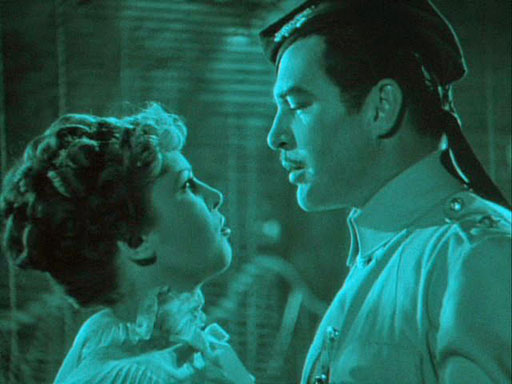 Seen today, Wee Willie Winkie bears out Shirley’s opinion more than it does Mosher’s, Flin’s or Nugent’s. The picture is certainly not too long. Children may squirm during the protracted love scenes between Michael Whalen and June Lang, but so do adults. Both were bland Fox contract players on an unstoppable career path toward B pictures and, at the onset of middle age, television. Whalen’s dark good looks were about to be rendered irrelevant by the rise of the far more charismatic Tyrone Power. As for Lang (Shirley’s “mother” was only 11 years older than she was), within seven years she would be a nameless, uncredited “Goldwyn Girl” behind Danny Kaye in Up in Arms, and would finish her career with one-off guest shots on TV cop shows in the ’50s and ’60s. Whalen and Lang were (and remain) attractive and inoffensive, but they lack the chemistry — with either the audience or each other — that Robert Young and Alice Faye showed in Stowaway, or Faye and Jack Haley in Poor Little Rich Girl. (The blue-green of this frame-cap, like the sepia of others, reproduces the tinted stock Wee Willie Winkie sported on its original release.)
Seen today, Wee Willie Winkie bears out Shirley’s opinion more than it does Mosher’s, Flin’s or Nugent’s. The picture is certainly not too long. Children may squirm during the protracted love scenes between Michael Whalen and June Lang, but so do adults. Both were bland Fox contract players on an unstoppable career path toward B pictures and, at the onset of middle age, television. Whalen’s dark good looks were about to be rendered irrelevant by the rise of the far more charismatic Tyrone Power. As for Lang (Shirley’s “mother” was only 11 years older than she was), within seven years she would be a nameless, uncredited “Goldwyn Girl” behind Danny Kaye in Up in Arms, and would finish her career with one-off guest shots on TV cop shows in the ’50s and ’60s. Whalen and Lang were (and remain) attractive and inoffensive, but they lack the chemistry — with either the audience or each other — that Robert Young and Alice Faye showed in Stowaway, or Faye and Jack Haley in Poor Little Rich Girl. (The blue-green of this frame-cap, like the sepia of others, reproduces the tinted stock Wee Willie Winkie sported on its original release.)
To be continued…

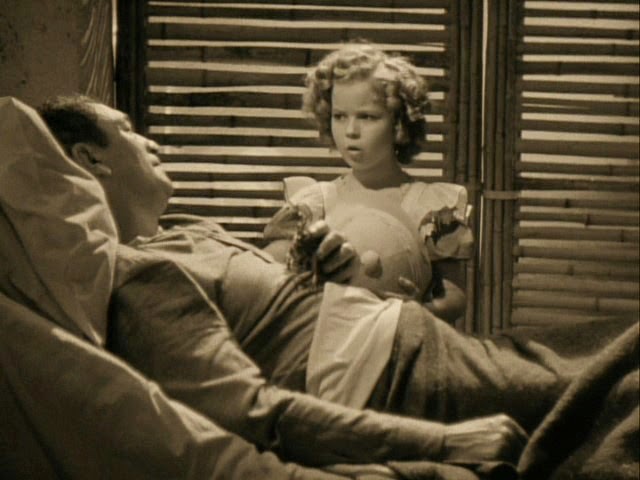
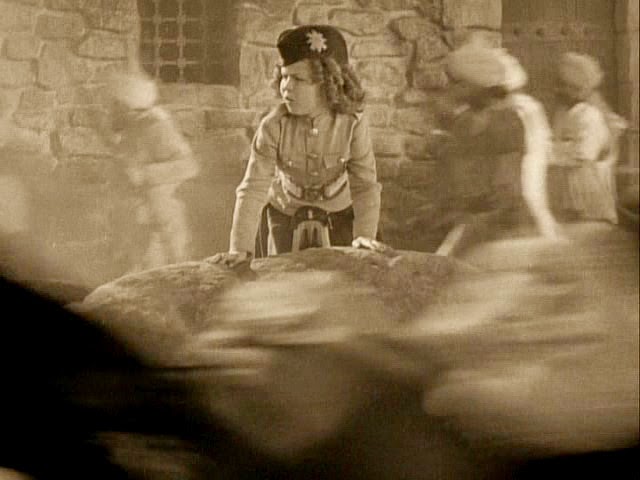
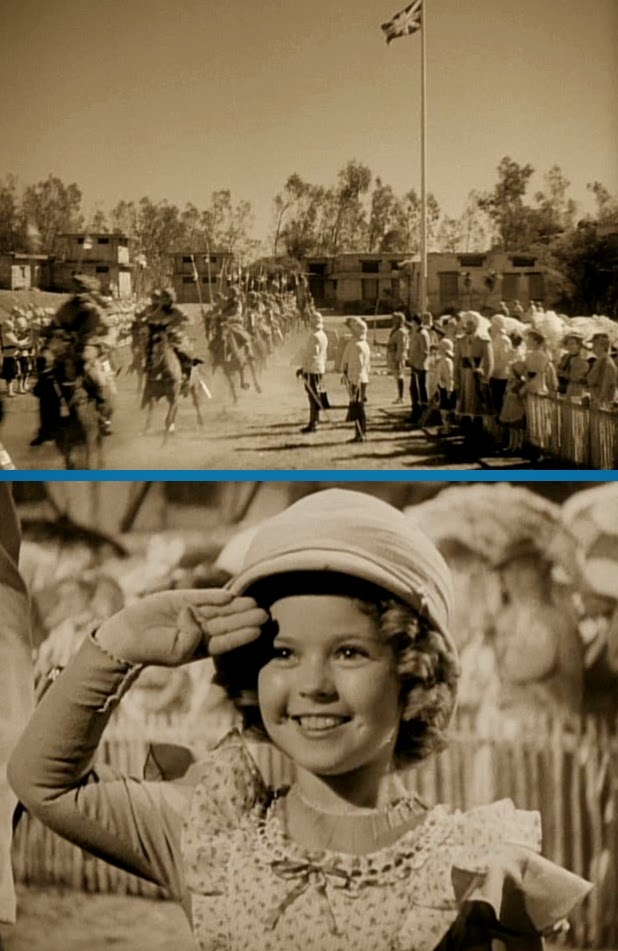
Silver: Regarding Greene's review, I'm with you; I think a red flag shoots up any time a grown man talks about an eight-year-old's "well-developed rump". Interesting, too, that he identifies Shirley's audience as "middle-aged men and clergymen", whereas Flin in Variety says it's "the kids who flock to see her". I'm more inclined to take Variety's word, but maybe things were different in England.
Re: Graham Greene's Review – Yikes! I felt uncomfortable reading it! I never would have viewed a Shirley Temple movie that way… I suppose I lead a sheltered life.
It's been a while since I've seen this one, but I do remember the scene that you described so well, with the different emotions flickering across Shirley's face when she's at McDuff's bedside. She was exceptional in that scene.